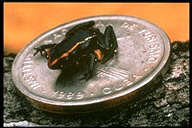The Indian Balloon Frog
Some frogs are colorful and look pretty and some are ugly. Other frogs are scary and others are amazing and mind bogglingg. The Hairy Frog, or "Trichobatrachus Robusts," is found in central Africa. Its name refers to the somewhat hair-like structures on the body and thighs of the male. The species is about 11 cm long from snout to length. Its head is broad with a short rounded snout. This species of frog is eaten in Cameroon. Another type of weird frog is the Indian Balloon Frog, or "Uperodon Globulosus." As you can guess, the balloon frog is a very plump, almost completely round frog. It comes from India and is one of the strangest looking frogs researchers have ever come across. The Northern Spadefoot Toad, or "Notaden Melanoscaphus," is another bizarre frog. It is a very round species, almost a complete sphere, and live almost anywhere. There is no distinction of the head from its body. The last type of weird frog is the Chubby Frog, or "Kaloula Pulchra." Chubby Frogs are native to Southeast Asia are commonly sold in pet stores. Other common names of this frog include Asian Painted Frog, Banded Bull Frog, Rice Frog, or Bubble Frog. It has a narrow-mouth and has a very round body. The Chubby Frog may live for as long as 11 years.




